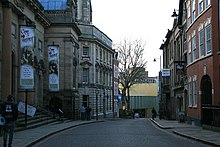High Pavement

High Pavement
|
|
| Maintained by | Nottingham City Council |
|---|---|
| Coordinates | 52°57′03″N 1°08′40″W / 52.9508°N 1.1444°WCoordinates: 52°57′03″N 1°08′40″W / 52.9508°N 1.1444°W |
High Pavement is a street in Nottingham, England. It is one of the earliest streets in the city, and most of its buildings are listed.
It runs from the east end of St. Mary's Churchyard to Weekday Cross. Around 1681 a row of houses was constructed on the south side of St. Mary's Churchyard. They existed until they were pulled down around 1792 when the street was widened. A new wall was constructed along the south side of the churchyard.
In 1799, the name of a portion of the street between Short Hill and St. Mary's Gate was called "St. Mary's Church Side". The name didn't take and was abandoned about 1815.
The Blue Coat School was located on High Pavement from 1723 to 1853.
In the Georgian era, High Pavement was one of the most fashionable places to live in Nottingham.
In 1819 a gas lamp was installed at the top of Drury Hill by the Nottingham Gas Light and Coke Company. Previous lighting had been by whale oil lamps.
On 8am 10 August 1864, the last public hanging was held. Richard Thomas Parker was hanged for the murder of his mother. He was buried in the precincts of the gaol by the side of Fenton and Saville.
15, 17 and 19 were demolished in 1931 to provide additional car parking for Shire Hall.
Joined at some point to No.56 High Pavement which it abuts. Possibly not a town house but erected specifically for commercial use in the lace or textile trade. There is machinery in the cellars and a hoist for the carriage of goods in the loft area with trapdoors evident below.
More recently used as Accountant's offices in conjunction with the No.56 building but internally many alterations have erased much of the interior including no sign of the original staircase. Whilst the loft area is broadly in a close to original state (with exposed reed walls, blue distemper surfaces and original floors) the other storeys have been remodelled and with only small areas of detail such as coving evident behind suspended ceilings. Repaired in recent years and now used as offices and a new media centre. Access to the rear is via a side gate which opens into a very small courtyard area which mainly serves the neighbouring buildings.
The front of No.54 has cellars carved from the sandstone which were used in part for the storage of coal; the architecture in this area only one floor below is curious in retaining evidence of a different layout to that currently including a redundant stone lintel. There are bricked up areas that appear not to have been recently explored but to the rear extensive work has taken place to create an additional office space with evidence of further unexplored spaces below.
...
Wikipedia

